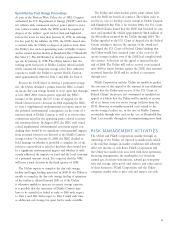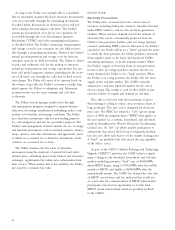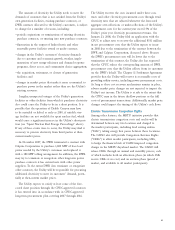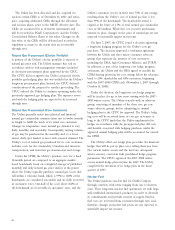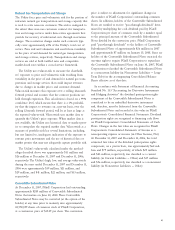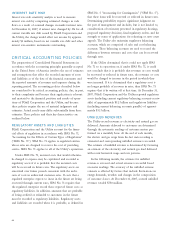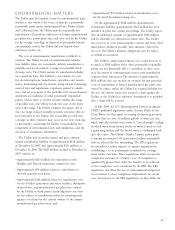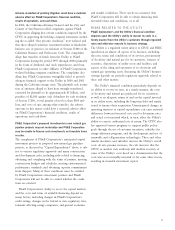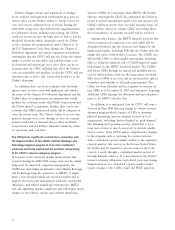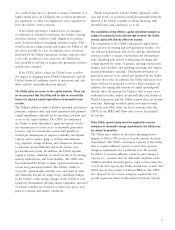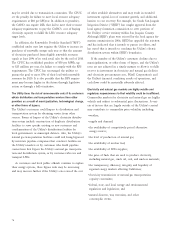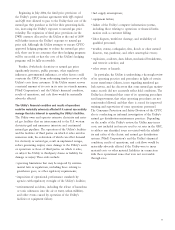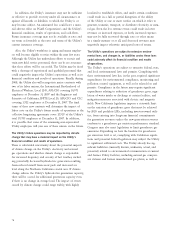PG&E 2007 Annual Report Download - page 71
Download and view the complete annual report
Please find page 71 of the 2007 PG&E annual report below. You can navigate through the pages in the report by either clicking on the pages listed below, or by using the keyword search tool below to find specific information within the annual report.69
ENVIRONMENTAL MATTERS
The Utility may be required to pay for environmental reme-
diation at sites where it has been, or may be, a potentially
responsible party under environmental laws. Under federal
and California laws, the Utility may be responsible for
remediation of hazardous substances at former manufactured
gas plant sites, power plant sites, and sites used by the Utility
for the storage, recycling, or disposal of potentially hazard-
ous materials, even if the Utility did not deposit those
substances on the site.
The cost of environmental remediation is diffi cult to
estimate. The Utility records an environmental remedia-
tion liability when site assessments indicate remediation is
probable and it can estimate a range of reasonably likely
clean-up costs. The Utility reviews its remediation liability
on a quarterly basis. The liability is an estimate of costs
for site investigations, remediation, operations and mainte-
nance, monitoring and site closure, using current technology,
enacted laws and regulations, experience gained at similar
sites, and an assessment of the probable level of involvement
and fi nancial condition of other potentially responsible
parties. Unless there is a better estimate within this range
of possible costs, the Utility records the costs at the lower
end of this range. The Utility estimates the upper end of
this cost range using reasonably possible outcomes that are
least favorable to the Utility. It is reasonably possible that
a change in these estimates may occur in the near term due
to uncertainty concerning the Utility’s responsibility, the
complexity of environmental laws and regulations, and the
selection of compliance alternatives.
The Utility had an undiscounted and gross environ-
mental remediation liability of approximately $528 million
at December 31, 2007 and approximately $511 million at
December 31, 2006. The $528 million accrued at December 31,
2007 consists of:
• Approximately $235 million for remediation at the
Hinkley and Topock natural gas compressor sites;
• Approximately $90 million related to remediation at
divested generation facilities;
• Approximately $152 million related to remediation costs
for the Utility’s generation and other facilities, third-party
disposal sites, and manufactured gas plant sites owned
by the Utility or third parties (including those sites that
are the subject of remediation orders by environmental
agencies or claims by the current owners of the former
manufactured gas plant sites); and
• Approximately $51 million related to remediation costs
for the fossil decommissioning sites.
Of the approximately $528 million environmental
remediation liability, approximately $132 million has been
included in prior rate setting proceedings. The Utility expects
that an additional amount of approximately $306 million
will be allowable for inclusion in future rates. The Utility
also recovers its costs from insurance carriers and from other
third parties whenever possible. Any amounts collected in
excess of the Utility’s ultimate obligations may be subject
to refund to customers.
The Utility’s undiscounted future costs could increase to
as much as $834 million if the other potentially responsible
parties are not fi nancially able to contribute to these costs,
or if the extent of contamination or necessary remediation
is greater than anticipated. The amount of approximately
$834 million does not include an estimate for any potential
costs of remediation at former manufactured gas plant sites
owned by others, unless the Utility has assumed liability for
the site, the current owner has asserted a claim against the
Utility, or the Utility has otherwise determined it is probable
that a claim will be asserted.
In July 2004, the U.S. Environmental Protection Agency
(“EPA”) published regulations under Section 316(b) of the
Clean Water Act that apply to existing electricity generation
facilities that use over 50 million gallons of water per day,
which typically include some form of “once-through” cooling
in which water from natural bodies of water is used to cool
a generating facility and the heated water is discharged back
into the source. The Utility’s Diablo Canyon power plant
is among an estimated 539 generation facilities nationwide
that are affected by this rulemaking. The EPA regulations
are intended to reduce impacts to aquatic organisms by
establishing a set of performance standards for cooling
water intake structures. These regulations allow site-specifi c
compliance measures if a facility’s cost of compliance is
signifi cantly greater than either the benefi ts to be achieved
or the compliance costs considered by the EPA. The EPA
regulations also allow the use of environmental mitigation
or restoration to meet compliance requirements in certain
cases. In response to the EPA regulations, in June 2006, the


